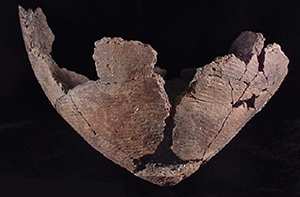Crossref Citations
This article has been cited by the following publications. This list is generated based on data provided by
Crossref.
Heron, Carl
and
Craig, Oliver E
2015.
Aquatic Resources in Foodcrusts: Identification and Implication.
Radiocarbon,
Vol. 57,
Issue. 4,
p.
707.
Heron, Carl
Craig, Oliver E.
Luquin, Alexandre
Steele, Valerie J.
Thompson, Anu
and
Piličiauskas, Gytis
2015.
Cooking fish and drinking milk? Patterns in pottery use in the southeastern Baltic, 3300–2400 cal BC.
Journal of Archaeological Science,
Vol. 63,
Issue. ,
p.
33.
Buonasera, Tammy Y.
Tremayne, Andrew H.
Darwent, Christyann M.
Eerkens, Jelmer W.
and
Mason, Owen K.
2015.
Lipid biomarkers and compound specific δ13C analysis indicate early development of a dual-economic system for the Arctic Small Tool tradition in northern Alaska.
Journal of Archaeological Science,
Vol. 61,
Issue. ,
p.
129.
Lovis, William A
and
Hart, John P
2015.
Fishing for Dog Food: Ethnographic and Ethnohistoric Insights on the Freshwater Reservoir in Northeastern North America.
Radiocarbon,
Vol. 57,
Issue. 4,
p.
557.
Skibo, James M.
Malainey, Mary E.
and
Kooiman, Susan M.
2016.
Early pottery in the North American Upper Great Lakes: exploring traces of use.
Antiquity,
Vol. 90,
Issue. 353,
p.
1226.
Sturm, Camilla
Clark, Julia K.
and
Barton, Loukas
2016.
The Logic of Ceramic Technology in Marginal Environments: Implications for Mobile Life.
American Antiquity,
Vol. 81,
Issue. 4,
p.
645.
Hart, John P.
Shafie, Termeh
Birch, Jennifer
Dermarkar, Susan
Williamson, Ronald F.
and
Crawford, Gary W.
2016.
Nation Building and Social Signaling in Southern Ontario: A.D. 1350–1650.
PLOS ONE,
Vol. 11,
Issue. 5,
p.
e0156178.
Kooiman, Susan M.
2016.
Woodland Pottery Function, Cooking, and Diet in the Upper Great Lakes of North America.
Midcontinental Journal of Archaeology,
Vol. 41,
Issue. 3,
p.
207.
Lucquin, Alexandre
Gibbs, Kevin
Uchiyama, Junzo
Saul, Hayley
Ajimoto, Mayumi
Eley, Yvette
Radini, Anita
Heron, Carl P.
Shoda, Shinya
Nishida, Yastami
Lundy, Jasmine
Jordan, Peter
Isaksson, Sven
and
Craig, Oliver E.
2016.
Ancient lipids document continuity in the use of early hunter–gatherer pottery through 9,000 years of Japanese prehistory.
Proceedings of the National Academy of Sciences,
Vol. 113,
Issue. 15,
p.
3991.
Anderson, Shelby L.
Tushingham, Shannon
and
Buonasera, Tammy Y.
2017.
AQUATIC ADAPTATIONS AND THE ADOPTION OF ARCTIC POTTERY TECHNOLOGY: RESULTS OF RESIDUE ANALYSIS.
American Antiquity,
Vol. 82,
Issue. 3,
p.
452.
Oras, Ester
Lucquin, Alexandre
Lõugas, Lembi
Tõrv, Mari
Kriiska, Aivar
and
Craig, Oliver E.
2017.
The adoption of pottery by north-east European hunter-gatherers: Evidence from lipid residue analysis.
Journal of Archaeological Science,
Vol. 78,
Issue. ,
p.
112.
Shoda, Shinya
Lucquin, Alexandre
Ahn, Jae-ho
Hwang, Chul-joo
and
Craig, Oliver E.
2017.
Pottery use by early Holocene hunter-gatherers of the Korean peninsula closely linked with the exploitation of marine resources.
Quaternary Science Reviews,
Vol. 170,
Issue. ,
p.
164.
Birch, Jennifer
and
Hart, John P.
2018.
SOCIAL NETWORKS AND NORTHERN IROQUOIAN CONFEDERACY DYNAMICS.
American Antiquity,
Vol. 83,
Issue. 1,
p.
13.
Deal, Michael
Farrell, Thomas
Hartery, Latonia
Harris, Alison
and
Sanders, Michael
2018.
Ceramics in Circumpolar Prehistory.
p.
168.
Lucquin, Alexandre
Robson, Harry K.
Eley, Yvette
Shoda, Shinya
Veltcheva, Dessislava
Gibbs, Kevin
Heron, Carl P.
Isaksson, Sven
Nishida, Yastami
Taniguchi, Yasuhiro
Nakajima, Shōta
Kobayashi, Kenichi
Jordan, Peter
Kaner, Simon
and
Craig, Oliver E.
2018.
The impact of environmental change on the use of early pottery by East Asian hunter-gatherers.
Proceedings of the National Academy of Sciences,
Vol. 115,
Issue. 31,
p.
7931.
Milano, Stefania
Lindauer, Susanne
Prendergast, Amy L.
Hill, Evan A.
Hunt, Chris O.
Barker, Graeme
and
Schöne, Bernd R.
2018.
Mollusk carbonate thermal behaviour and its implications in understanding prehistoric fire events in shell middens.
Journal of Archaeological Science: Reports,
Vol. 20,
Issue. ,
p.
443.
Hayden, Brian
2018.
Ceramics in Circumpolar Prehistory.
p.
216.
Oras, Ester
Tõrv, Mari
Jonuks, Tõnno
Malve, Martin
Radini, Anita
Isaksson, Sven
Gledhill, Andy
Kekišev, Ott
Vahur, Signe
and
Leito, Ivo
2018.
Social food here and hereafter: Multiproxy analysis of gender-specific food consumption in conversion period inhumation cemetery at Kukruse, NE-Estonia.
Journal of Archaeological Science,
Vol. 97,
Issue. ,
p.
90.
Hart, John P.
Taché, Karine
Lovis, William A.
and
Loor, Juan J.
2018.
Freshwater reservoir offsets and food crusts: Isotope, AMS, and lipid analyses of experimental cooking residues.
PLOS ONE,
Vol. 13,
Issue. 4,
p.
e0196407.
Jordan, Peter
and
Gibbs, Kevin
2018.
Ceramics in Circumpolar Prehistory.
p.
1.
